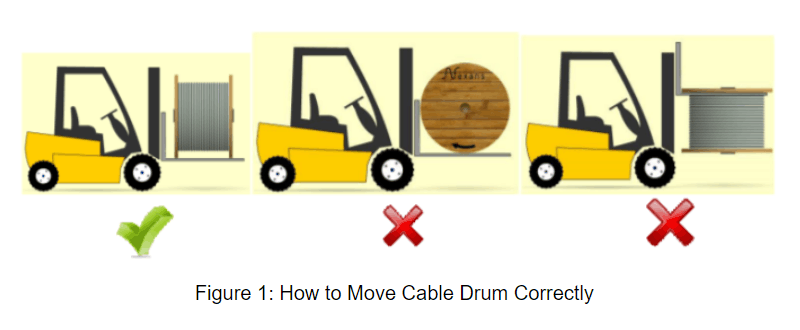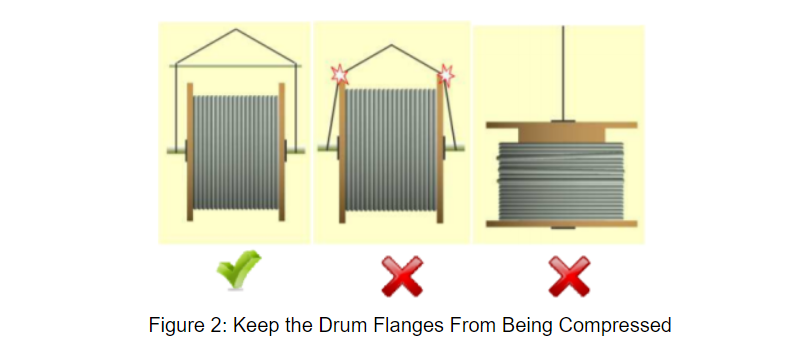Fiber Optic Cable Storage Tips
Fiber optic cables are sensitive to excessive pulling, bending, twisting, crushing and other impact forces, which may alter the fiber property and may pose threats to its performance. Therefore, optical cable should be stored and handled in an appropriate way. This article offers fiber optic cable storage tips in five main aspects in detail.
Before Storage: How to Move Cable Drum Correctly
Before storing an optical fiber, it is important to transport or move it correctly because many optical fibers are heavy. Cable drum movement is one of the common ways for fiber transportation. When the cable drum/reel is too heavy to lift manually, it must be moved upright by lifting the cable with a forklift or reel mover. Never drop a cable reel from any height during transportation or use. When unloading from a vehicle, use either the tail-lift/elevator (if fitted) or a suitable mechanical aid such as a forklift truck. Never let reels drop from the vehicle to the ground.
When moving or handling the drum by a forklift, one should operate it in a proper manner to avoid any damage to fiber optic cable. The fork should not have any direct contact with the cable jacket.
Some drums may be of sufficient length and weight to require cranes to load and unload from transport vehicles. Under such circumstances, a spreader bar of sufficient length is necessary to keep the drum flanges from being compressed by the lifting chains.
Where Should Fiber Optic Cable Be Stored?
In no circumstances shall any cable boxes or reels be stored outside or in a harsh environment. Instead, these cables should be stored in a dry and UV protected location, such as a room or container. Choose a site for storage with no risk of excessive humidity, falling objects, chemical spills (oil, grease,etc.), open flames or excessive heat. Elements like moisture and other contamination should also be considered when picking storage locations.
Note: Although the cables can be stored out of doors, the appearance of the reel can suffer weathering or other damages due to the changeable weather. Therefore, storing all reels indoors is recommended.
Fiber Optic Cable Storage Requirements
There are four main requirements listed below one should pay attention to when storing fiber optic cables. These requirements matter a lot for the whole performance of the optical cables.
Store with seals: always keep the reel seal/tag that comes with the cable. There is vital information on the tag which indicates the cable description, attenuation, bandwidth and cable length. All these are valid identification of the fiber optic cable for future traceability.
Keep the drum stressed uniformly on a level and firm surface: store fiber optic cable drum/reel standing on both flanges on a level and firm surface. Never store a cable reel sitting on one flange surface, which will result in possible future cable damage when unwinding.
Keep the protective end-caps on the fiber cable: make sure to keep the protective end-caps on the cable. The end caps are designed to prevent the ingress of moisture into the end of the cable. They protect the most sensitive part of the fiber assemblies. Once removed, the core of the cable will be exposed to the contaminants in the environment surrounding it, which increases the risk of fiber scratching and pitting.
Don’t exceed the minimum bending radius while changing reels: once rewind the fiber optic cable to another reel, the diameter of the new reel should be not less than the minimum bending radius of the cable. And the original cable label details should be copied to the new reel.
Inspection and Maintenance After Storage
After the storage, fiber inspection and maintenance also matters. Through inspecting, one can find possible damage caused during fiber optic cable storage. If possible, check the condition of the end caps first. If the end cap is absent, a heat shrink cap should be applied to ensure a tight seal to the cable outer layer.
Safety Requirements After Fiber Optic Cable Storage
For safety concern, there are many aspects one should pay attention to when handing with the fiber optic cable. Here are several main requirements.
- Wear disposable aprons to minimize fiber particles on your clothing and keep all food and beverages out of the work area. If fiber particles are ingested they can cause internal hemorrhaging.
- Always wear safety glasses with side shields, suitable safety helmet, safety belts and protective gloves. Do not touch your eyes while working with fiber optic systems.
- Never look directly through the end of fiber cables unless there is no light source at the other end.
- Only work in well-ventilated areas and do not smoke while working with fiber optic systems.
- Wash your hands carefully after working with fiber optic cables.
- Don’t use isopropyl alcohol as a cleaner as it is flammable.
In addition to the precautions for fiber optic cable storage, there are many tips when installing or using optical fibers as well. For example, try to avoid sharp bending of the optical cable, avoid pulling the optical cable forcibly, and provide lightning protection for the optical cable. For more details, refer to Fiber Optic Cable Installation Tips and Lightning Protection System for Fiber Optic Cables.
Source: community.fs
Related products...
fiber-optic-cable
Optical fiber cable 3m American 6 core, multimode, (6*1), MM 50, LSZH, anti-rodent
fiber-optic-cable
DRAKA fiber optic cable 24 core (1*24), singlemode Armored-Out
fiber-optic-cable


















[ratings]